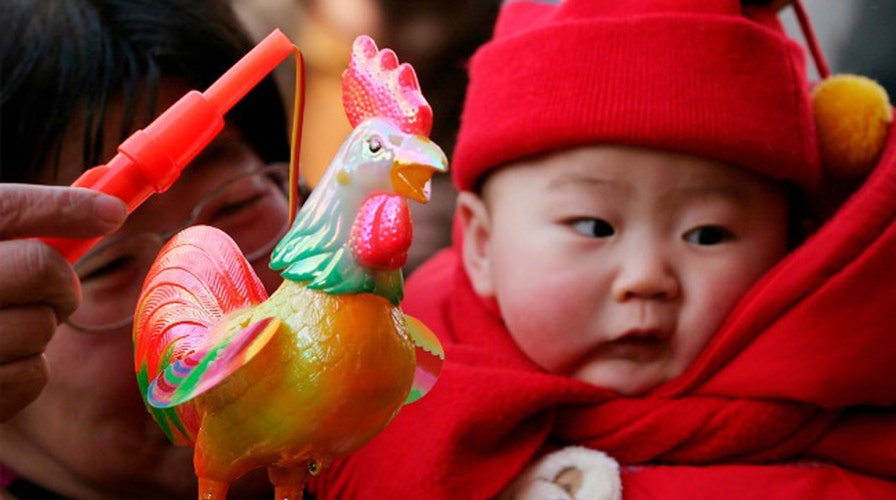China to allow married couples to have two children
On 'Shepard Smith Reporting,' researchers say restrictions led to imbalanced gender ratio
Governmental reform plans have been known since Hammurabi drafted his first set of law codes over 3,000 years ago. The repeated cycles of reform and reaction are as much an exercise designed to keep government scribes and bureaucrats busy, as they are intended to affect the activities of the people under central control. Rarely, however, does reform directly impact the most intimate matters of the lives of citizens or subjects.
Such is not the case with China’s announcement Wednesday that the country’s 35-year old infamous one-child policy is to be scrapped.
Imposed when Chinese leaders feared that their then-800 million strong population would grow to an extent that would make it impossible to feed or control, the policy was perhaps the most egregious imposition of state control on the lives of Chinese citizens.
No one will ever know the true figures, but anywhere from 200 to 400 million births were “averted” thanks to the policy. Its brutality, also, was legendary, as pregnant women were forced to undergo abortions or sterilization.
The policy may have successfully retarded the growth of China’s population, but as with all large-scale or intrusive central government plans, it resulted in significant unanticipated consequences.
Since male babies are valued more for their eventual labor abilities, female fetuses were aborted as a matter of practice. China now has one of the most imbalanced sex ratios, with 116 males born for every 100 females.
Perhaps the most damaging was a skewing of the sex ratio at birth, thanks to sex-selective abortions practiced by expectant parents. Since male babies are valued more for their eventual labor abilities, female fetuses were aborted as a matter of practice. China now has one of the most imbalanced sex ratios, with 116 males born for every 100 females. This already is leading to the inability of millions of Chinese men to find mates; by some estimates up to 25 percent of Chinese males cannot find brides.
Another consequence was the number of Chinese who got around the prohibition, sometimes by giving birth outside the country, other times by simply ignoring the edict. Yet, overall, it was wildly successful.
Now, China faces the fruits of its policy: an aging population. China’s fertility rate slipped below replacement rate back in the early-1990s, and now the country is facing the beginnings of a labor shortage. Over the next 20 years, China’s working age population (15-64 years of age) is expected to shrink by nearly 60 million. This means further stress on wages, which have been increasing and leading to reduced competitiveness for Chinese companies, and a drag on the manufacturing sector.
It also means that a bulge of older citizens will have to be supported by fewer workers, increasing the pressure on government to provide a firmer social safety net.
In short, as is now common to say, China will become old before it becomes rich.
Hence the dramatic announcement that the government will step out of China’s bedrooms, at least partially. After hesitant reform in 2013, to allow rural families to have more than one child, all Chinese will now be allowed to have two children. While the state will ostensibly still monitor the reproductive activity of its citizens, the move is perhaps the beginning of a major wave of reform in China, spurred by the recognition that the country’s golden era of growth is over.
Slowing economic growth will drive the Chinese Communist Party to make difficult choices. While any type of political liberalization appears to be off the table, especially given the tightening of control by President Xi Jinping, China’s leaders may have to allow a greater loosening of entrepreneurial spirit and individual activity.
Allowing couples to have two children might well be seen as tacit recognition that the private sphere in China will have to be respected more in the future.
Yet there are no easy solutions to China’s looming problems. In fact, the modicum of greater freedom given by the government to the family planning of its citizens may, in fact, not result in a new baby boom. Like many maturing economies, China may find that its younger generations don’t want to accept the burdens of raising more children in a more uncertain and expensive economic environment. That, ironically, could result in more drastic action being taken by Beijing, though-- as their neighbors, the Japanese, can attest-- there is little bureaucrats can do to make more babies.
In the end, what the end of the one-child policy represents may be as simple as a dramatic recognition that the next era in Chinese history will be one of trying to find solutions to problems that have simmered for decades.
There will be successes and failures, but the big picture will be one of a government torn between accepting the need for real reform while avoiding any moves that may undermine its hold on power.
Call it the Great Era of Muddling Through.

